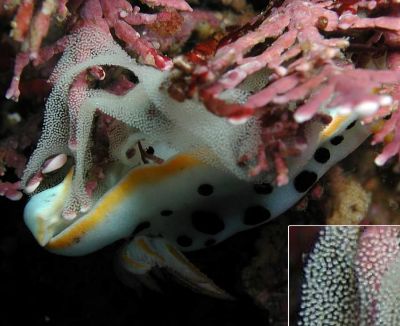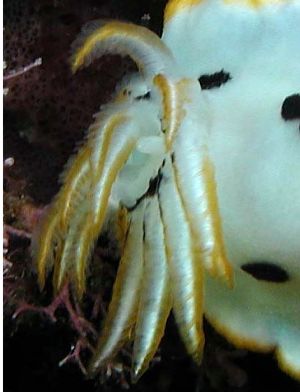About Chromodoris orientalis
August 30, 2001
From: Nishina Masayoshi

Dear Dr.Rudman,
Thanks for your comments. I believe that a deep yellow mantle border is a more common colour form here. I believe that the pale coloured Chromodoris orientalis we saw and Imamoto sent at Echizen Coast is rather say rare.
I often see the dendritic branching of the mantle glands on C. orientalis here,
but I don't know why sometimes it disappear and sometimes it's very noticeable. Following your comment "The way the inner edge of each gill has a black or dark brown line", I checked all of my photos of C. orientalis and studied their gills.
I believe that this C. orientalis with black or dark brown line is rather common in Japan. C. orientalis with an orange line does occur but not commonly. It is the same on the Pacific coast such as Sagami Bay and Japan Sea coast such as Echizen. So it is not because of geographical reason. I seldom thought that the shade of a color was a feature of gills.
Baba described this species as Glossodoris pallescens(Bergh) in his book Opisthobranchs of Sagami Bay, and he mentioned just "color of gill is yellow" No more detailed description. Here are photos of two different typical gills of C. orientalis'
We are learning many things from the from you through this Forum. I understand now that the form of the egg mass becomes very important data about the species. So we have been trying to find and take a photo of it and have succeeded. This species is present in large numbers at present so it is simple to find it, and observe it.
The photos were all taken at Echizen Coast on 12 Aug, 2001. Length of animals was between 30mm to 40mm.
PS: Yasuhiro also has an interesting photo on his website http://www.sea-slug.com/species/index2.html
Best Regards,
Nishina Masayoshi
nishina@hpe15.wips.co.jp



Dear Nishina,
Thanks for all this interesting information. The egg ribbon is rather interesting. Both your photo and Yasuhiro's show an egg ribbon which is attached along one edge, which is different from the 'flattened spiral' that I mentioned that Baba, Hamatani & Hisai had described for this species. Both your photo and Yasuhiro's show an egg ribbon being deposited on coralline algae. Although it doesn't seem very likely, it would be interesting to know if the egg ribbon is laid differently on a rock or other flat surface.
I have attached alongside the drawing from Baba, Hamatani & Hisai, 1956. They say:
"Spawning ... most active from July to early August... In Toyama Bay and Sado Island ... the full grown animals come together in enormous numbers .. copulate and lay eggs .... the egg mass is distinct in being laid flat on the substratum. It consists of a long and ashy white ribbon, coiled tightly in about 2 and a half convolutions ..."
Best wishes,
Bill Rudman
Related messages
-
Chromodoris orientalis from Sth Korea
From: Kevin Lee, April 2, 2007 -
Two-headed Chromodoris orientalis from Japan
From: Tomohiko Kurihara, June 8, 2002 -
Chromodoris orientalis from Japan
From: Nishina Masayoshi, August 29, 2001 -
Chromodoris orientalis from Japan
From: Jun Imamoto, August 29, 2001 -
Chromodoris orientalis from Taiwan
From: Bernard Picton , July 24, 2001 -
Chromodoris orientalis from Hong Kong
From: Leslie Chan, July 15, 2001 -
Chromodoris orientalis from Hong Kong
From: Bill Rudman & Brian Darvell, July 15, 2001
